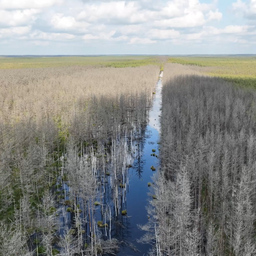Kikepera looduskaitsealal Pärnumaal plaanitakse
taastada veerežiim
. Kraavid, mis aastakümneid tagasi kaevatud, tahetakse sulgeda. Tööd peaksid toimuma 3800 hektaril. Keskkonnaameti nõunik Agu Leivits ütleb, et need tööd on kavas kaitsekorralduskavas. Tööde eesmärk on
parandada metsise elupaiku
. Kikepera põhjaosas on samasugused tööd juba tehtud ja need on andnud head tulemused. Seal elab ka Eesti suurim metsise mäng ja Kikepera on Eesti üks olulisemaid linnu alasid. Saarde vallavolikogu aseesimees Kadri Aija-Viik ütleb, et vald ja
kohalikud on plaani vastu
. Nad arvavad, et see hävitab aastatega väljakujunenud maastiku, rikub teid ja
suurendab üleujutusohtu
. Aija-Viik lisab, et aastatel 1960 tehti juba ebamõistlikke töid, kui kraavid kaevatud ja nüüd plaanitakse samasugust. Ta ei usu, et vesi ei tõuseks. Alal on ligi miljon tihumeetrit puitu, mis hakkab mädanema. Aija-Viik ei mõista, miks osa puitu ei eemaldata enne töid. Metsise seisund on juba paranenud ilma uute tööta. Metsis on seal alati elanud ja tema peamine vaenlane on kiisk. Kohalikud on korraldatud küsitluses plaani vastu. Saunametsa küla elanik Peeter Elvelt ütleb, et pärast töid tuleb veel suurem üleujutusoht. Elvelt räägib, et tema ja tema kogukond on väga plaani vastu. Jõe veetase on nii kõrge, et vesi läheb Katku rabakraavidesse. Kui kraavid kinni pannakse, siis saab küla kõik vee enda peale. Eestimaa Looduse Fondi märgalade programmi juht Jüri-Ott Salm ütleb, et tööd ei too kaasa suurt maastikumuutust ega metsade hukkumist. Ta ütleb, et nad
modelleerivad vee liikumist
ja suudavad ennustada, kus vesi tõuseb. Kraavid metsateede ääres jäävad alles ja kuivendused ka jäävad. Agu Leivits ütleb, et eesmärk ei ole
metsa suretada
, kuigi see on juhtunud. Ta räägib, et töid tuleb hoolikalt planeerida, et seda vältida. Salm ütleb, et kogukonna ettepanekuid on arvestatud ja tööde hulka vähendatud. Metsa maharaiumist enne töid ta ei soovita, sest see ei sobi metsise kaitse vaatepunktist. Töödega
loodetakse alustada selle aasta sügisel
.
taastada veerežiim
Tõlge fraasile: taastada veerežiim
EN
restore the water regime
parandada metsise elupaiku
Tõlge fraasile: parandada metsise elupaiku
EN
improve the capercaillie's habitat
kohalikud on plaani vastu
Tõlge fraasile: kohalikud on plaani vastu
EN
locals are against the plan
suurendab üleujutusohtu
Tõlge fraasile: suurendab üleujutusohtu
EN
increase the risk of flooding
modelleerivad vee liikumist
Tõlge fraasile: modelleerivad vee liikumist
EN
model the movement of water
metsa suretada
Tõlge fraasile: metsa suretada
EN
kill the forest
loodetakse alustada selle aasta sügisel
Tõlge fraasile: loodetakse alustada selle aasta sügisel
EN
it is hoped to start this autumn
In the Kikepera Nature Reserve in Pärnu County, plans are underway to restore the water regime. Ditches dug decades ago are to be closed. The work is expected to cover 3,800 hectares. Agu Leivits, an advisor at the Environmental Board, says these works are part of the conservation management plan. The aim is to improve the habitats of the capercaillie. Similar works have already been carried out in the northern part of Kikepera and have yielded good results. The area is home to Estonia's largest capercaillie lek, and Kikepera is one of the country's most important bird areas. Kadri Aija-Viik, deputy chair of the Saarde Parish Council, says the parish and locals are against the plan. They believe it will destroy the landscape shaped over the years, damage roads, and increase the risk of flooding. Aija-Viik adds that in the 1960s, unreasonable works were carried out when the ditches were dug, and now similar actions are planned. She does not believe that the water will not rise. There are nearly a million cubic meters of wood in the area that will start to rot. Aija-Viik does not understand why some of the wood is not removed before the works. The capercaillie population has already improved without new works. Capercaillies have always lived there, and their main enemy is the pine marten. Locals have been surveyed and are against the plan. Peeter Elvelt, a resident of Saunametsa village, says there will be an even greater risk of flooding after the works. Elvelt says he and his community strongly oppose the plan. The river water level is so high that the water flows into the Katku bog ditches. If the ditches are closed, all the water will end up in the village. Jüri-Ott Salm, head of the wetlands program at the Estonian Fund for Nature, says the works will not lead to significant landscape changes or the death of forests. He says they model water movement and can predict where the water will rise. Ditches along forest roads will remain, and drainage will also stay in place. Agu Leivits says the goal is not to kill the forest, although it has happened. He says the works must be carefully planned to avoid this. Salm says community proposals have been considered, and the scope of the works has been reduced. He does not recommend cutting down trees before the works, as it is unsuitable from a capercaillie conservation perspective. The works are expected to begin this autumn.

